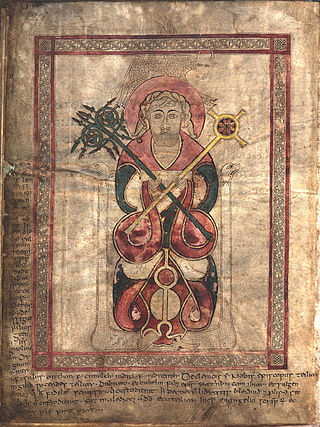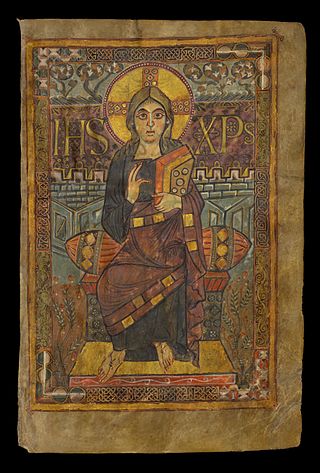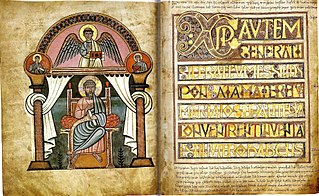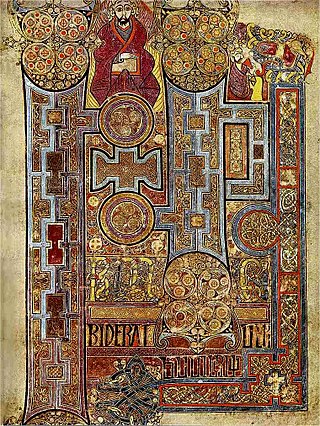
The Lindisfarne Gospels is an illuminated manuscript gospel book probably produced around the years 715–720 in the monastery at Lindisfarne, off the coast of Northumberland, which is now in the British Library in London. The manuscript is one of the finest works in the unique style of Hiberno-Saxon or Insular art, combining Mediterranean, Anglo-Saxon and Celtic elements.

The Book of Kells is an illuminated manuscript and Celtic Gospel book in Latin, containing the four Gospels of the New Testament together with various prefatory texts and tables. It was created in a Columban monastery in either Ireland or Scotland, and may have had contributions from various Columban institutions from each of these areas. It is believed to have been created c. 800 AD. The text of the Gospels is largely drawn from the Vulgate, although it also includes several passages drawn from the earlier versions of the Bible known as the Vetus Latina. It is regarded as a masterwork of Western calligraphy and the pinnacle of Insular illumination. The manuscript takes its name from the Abbey of Kells, County Meath, which was its home for centuries.

The Book of Durrow is an illuminated manuscript dated to c. 700 that consists of text from the four Gospels gospel books, written in an Irish adaption of Vulgate Latin, and illustrated in the Insular script style.

The Book of Deer is a 10th-century Latin Gospel Book with early 12th-century additions in Latin, Old Irish and Scottish Gaelic. It contains the earliest surviving Gaelic writing from Scotland.

The Lichfield Gospels is an 8th-century Insular Gospel Book housed in Lichfield Cathedral. There are 236 surviving pages, eight of which are illuminated. Another four contain framed text. The pages measure 30.8 cm by 23.5 cm. The manuscript is also important because it includes, as marginalia, some of the earliest known examples of written Old Welsh, dating to the early part of the 8th century. The art historian Peter Lord dates the book at 730, placing it chronologically before the Book of Kells but after the Lindisfarne Gospels.

The Ada Gospels is a late eighth century or early ninth century Carolingian gospel book in the Stadtbibliothek, Trier, Germany. The manuscript contains a dedication to Charlemagne's sister Ada, from where it gets its name. The manuscript is written on vellum in Carolingian minuscule. It measures 14.5 by 9.625 inches. The Ada Gospels are one of a group of manuscript illuminations by a circle of scriptoria that represent what modern scholars call the "Ada School". Other products of the Ada School include the Soissons Gospels, Harley Golden Gospels, Godescalc Evangelistary and the Lorsch Gospels; ten manuscripts in total are usually recognised.

The Echternach Gospels were produced, presumably, at Lindisfarne Abbey in Northumbria around the year 690. This location was very significant for the production of Insular manuscripts, such as the Durham Gospels and the Lindisfarne Gospels. The scribe of the Durham Gospels is believed to have created the Echternach Gospels as well. The Echternach Gospels are now in the collection of France's Bibliothèque Nationale in Paris.

The Irish Gospels of St. Gall or Codex Sangallensis 51 is an 8th-century Insular Gospel Book, written either in Ireland or by Irish monks in the Abbey of St. Gall in Switzerland, where it is now in the Abbey library of St. Gallen as MS 51. It has 134 folios. Amongst its eleven illustrated pages are a Crucifixion, a Last Judgement, a Chi Rho monogram page, a carpet page, and Evangelist portraits.

Insular script is a medieval script system originating from Ireland that spread to England and continental Europe under the influence of Irish Christianity. Irish missionaries took the script to continental Europe, where they founded monasteries such as Bobbio. The scripts were also used in monasteries like Fulda, which were influenced by English missionaries. They are associated with Insular art, of which most surviving examples are illuminated manuscripts. It greatly influenced modern Gaelic type and handwriting.

The Godescalc Evangelistary, Godescalc Sacramentary, Godescalc Gospels, or Godescalc Gospel Lectionary is an illuminated manuscript in Latin made by the Frankish scribe Godescalc and today kept in the Bibliothèque nationale de France. It was commissioned by the Carolingian king Charlemagne and his wife Hildegard on October 7, 781 and completed on April 30, 783. The Evangelistary is the earliest known manuscript produced at the scriptorium in Charlemagne's Court School in Aachen. The manuscript was intended to commemorate Charlemagne's march to Italy, his meeting with Pope Adrian I, and the baptism of his son Pepin. The crediting of the work to Godescalc and the details of Charlemagne's march are contained in the manuscript's dedication poem.

The Vespasian Psalter is an Anglo-Saxon illuminated psalter decorated in a partly Insular style produced in the second or third quarter of the 8th century. It contains an interlinear gloss in Old English which is the oldest extant English translation of any portion of the Bible. It was produced in southern England, perhaps in St. Augustine's Abbey or Christ Church, Canterbury or Minster-in-Thanet, and is the earliest illuminated manuscript produced in "Southumbria" to survive.

British Library, Add MS 11848 is an illuminated Carolingian Latin Gospel Book produced at Tours. It contains the Vulgate translation of the four Gospels written on vellum in Carolingian minuscule with Square and Rustic Capitals and Uncials as display scripts. The manuscript has 219 extant folios which measure approximately 330 by 230 mm. The text is written in area of about 205 by 127 mm. In addition to the text of the Gospels, the manuscript contains the letter of St. Jerome to Pope Damasus and of Eusebius of Caesarea to Carpian, along with the Eusebian canon tables. There are prologues and capitula lists before each Gospel. A table of readings for the year was added, probably between 1675 and 1749, to the end of the volume. This is followed by a list of capitula incipits and a word grid which were added in the Carolingian period.

The Stockholm Codex Aureus is a Gospel book written in the mid-eighth century in Southumbria, probably in Canterbury, whose decoration combines Insular and Italian elements. Southumbria produced a number of important illuminated manuscripts during the eighth and early ninth centuries, including the Vespasian Psalter, the Stockholm Codex Aureus, three Mercian prayer books, the Tiberius Bede and the British Library's Royal Bible.

British Library, Royal MS 1. B. VII, also called the Royal Athelstan Gospels, is an 8th-century Anglo-Saxon illuminated gospel book. It is closely related to the Lindisfarne Gospels, being either copied from it or from a common model. It is not as lavishly illuminated, and the decoration shows Merovingian influence. The manuscript contains the four Gospels in the Latin Vulgate translation, along with prefatory and explanatory matter. It was presented to Christ Church, Canterbury in the 920s by King Athelstan, who had recorded in a note in Old English (f.15v) that upon his accession to the throne in 925 he had freed one Eadelm and his family from slavery, the earliest recorded manumission in (post-Roman) England.

The Schuttern Gospels is an early 9th century illuminated Gospel Book that was produced at Schuttern Abbey in Baden. According to a colophon on folio 206v, the manuscript was written by the deacon Liutharius, at the order of his abbot, Bertricus.

British Library, Egerton MS 609 is a Breton Gospel Book from the late or third quarter of the ninth century. It was created in France, though the exact location is unknown. The large decorative letters which form the beginning of each Gospel are similar to the letters found in Carolingian manuscripts, but the decoration of these letters is closer to that found in insular manuscripts, such as the Book of Kells and the Lindisfarne Gospels. However, the decoration in the Breton Gospel Book is simpler and more geometric in form than that found in the Insular manuscripts. The manuscript contains the Latin text of St Jerome's letter to Pope Damasus, St. Jerome's commentary on Matthew, and the four Gospels, along with prefatory material and canon tables. This manuscript is part of the Egerton Collection in the British Library.

Insular art, also known as Hiberno-Saxon art, was produced in the post-Roman era of Great Britain and Ireland. The term derives from insula, the Latin term for "island"; in this period Britain and Ireland shared a largely common style different from that of the rest of Europe. Art historians usually group Insular art as part of the Migration Period art movement as well as Early Medieval Western art, and it is the combination of these two traditions that gives the style its special character.

The Gospels of Máel Brigte is an illuminated Gospel Book, with glosses.

The Athelstan Gospels, or British Library, Cotton MS Tiberius A. ii is a late 9th or early 10th-century Ottonian illuminated Gospel book which entered England as a gift to King Athelstan, who in turn offered it to Christ Church, Canterbury. It is also referred to as the Coronation Gospels on account of an early modern tradition that it had been used as an oath-book at English coronations.

The Mac Durnan Gospels or Book of Mac Durnan is an illuminated manuscript Gospel book made in Ireland in the 9th or 10th century, a rather late example of Insular art. Unusually, it was in Anglo-Saxon England soon after it was written, and is now in the collection of Lambeth Palace Library in London.





















